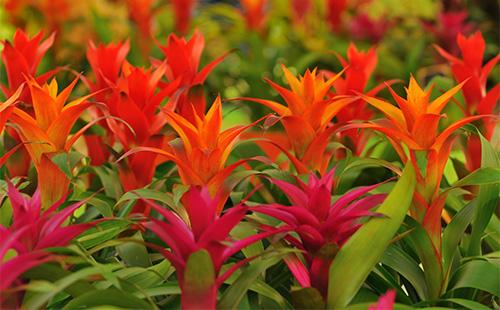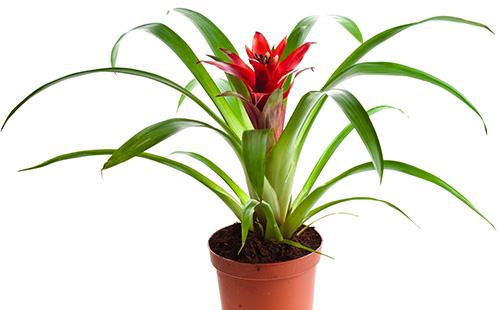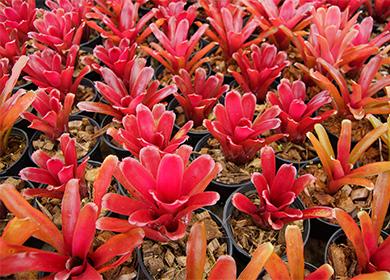The content of the article
The genus Bromeliad counts about 50 plant species. All of them grow in a warm tropical climate, mainly in South America. Many types of bromeliad are grown as indoor crops - care for them is about the same.
A whole mix of requests is insanely popular on the Internet - where to buy a bromeliad de sapato flower. But no matter what you enter in the search line - bromeliya de sapata, or bromeliya di sapato, or even bromelia de sapato - you will not find where to buy such a flower. The fact is that the photo of the plant on which the inverted bright pointed-toe women’s stilettos are collected in an inflorescence is nothing but an April Fool’s joke. And if they will assure you that such a plant exists, and it’s called so, because its name comes from the Portuguese “sapato” - boot - do not believe it.
Botanical Description
A compact rosette is formed from fleshy, dense leaves of an elongated shape. The color is dark green, in some varieties a beautiful marble pattern is expressed. Flowers of different shades, but always bright, expressive and large. The inflorescence is magnificent, rises from the center of the outlet on a powerful peduncle.
Bromeliad belongs to epiphytic plants, that is, it receives food not only from the soil, but also from the air, therefore it can grow on very poor soils. As a support, the plant chooses trees, large stones. Some types of bromeliad in nature reach three meters in height. Low-growing, mostly hybrid, varieties are grown in apartments.
The only drawback of bromeliad is that it blooms only once in a lifetime. Then the main mother socket gradually dies. Long flowering - lasts several months. To replace the dead outlet, children are formed.
Caring for bromeliads and creating a suitable microclimate
Bromeliad belongs to tropical cultures, needs a special microclimate and care. The main reason for the death of the plant is improper watering. Unsuitable humidity, temperature and lighting also negatively affect the condition of the flower. Care for the flower of bromeliad consists in maintaining favorable microclimate parameters, proper watering and systematic spraying.
- Lighting. Bromeliad is placed in a well-lit place, but they are not allowed to be exposed to direct sunlight - sunburns easily form on its leaves. The optimal location is the west or east side with a slight shade of light tulle. On the north window, bromeliad fades and does not bloom.
- Temperature. Tropical thermophilic plant makes high demands on the temperature of the content. In summer, it is maintained at 25 ° C. In winter and during flowering, relative coolness is needed - about 18 ° C. It withstands short-term temperature drops to 12 ° C. When choosing a place, the increased sensitivity of bromeliad to drafts is taken into account.
- Watering. Water bromeliad need not like other indoor crops. Water is poured directly into the outlet. In warm time, they are watered quite often - at intervals of two to four days. In autumn and winter, one watering per week is enough. Drying of the root system is not allowed.
- Humidity. Optimum humidity - not lower than 60%. Bromeliads need regular spraying. A flower pot is placed on a pallet with wet moss, decorative pebbles or expanded clay. You can use special humidifiers.
- Top dressing. Homemade bromeliad gratefully responds to fertilizer application. It can be fed with special liquid complexes for bromeliads no more than once every two to three weeks. When using other fertilizers, they look so that there is no copper and boron in the composition. They have a toxic effect on bromeliad. In nature, culture costs a small amount of nutrients, so it is important not to exceed the dosage. The fertilizer solution is applied by analogy with watering - directly into a leaf outlet.
- The soil. The root system needs loose, breathable soil. It is prepared from sheet earth, sand, peat and humus. To improve the properties of the soil, a small amount of birch coal, turf and coniferous earth can be added to it.
- After flowering. If bromeliad has faded and began to fade, there is no need to try to revive it. This is a natural process. Caring for bromeliads after flowering is aimed at accelerating the growth of young shoots. The maternal outlet is not removed until the children get stronger.
Transplanting bromeliads after purchase is optional. The only indications for transplanting are a very small pot or poor soil. Bromeliad does not like transplants, it often gets sick after them. Therefore, everything needs to be done quickly and accurately. Prepare a larger pot in advance, wash it well and sterilize it. The soil is calcined in a pan, cooled, poured into a container. In the center they make a deepening and pour water there. Carefully plant bromeliad with a lump of earth. Add soil, slightly compact. The first time after transplantation is kept in a shaded place.

Propagation Features
Reproduction of bromeliad at home is performed with the help of children, formed after the death of the main outlet. Children are considered ready for transplantation when they have reached half the height of the mother plant, have grown their own root system. From the moment children appear until they are ready for a transplant, about a year passes. To plant bromeliad, follow the following sequence of actions.
- Training. The mother plant is carefully removed from the pot, freed from the soil.
- Kids department. The roots are washed with water, with a sharp knife, the children are carefully separated from the main plant. Slices are treated with coal powder, the children are left for a day to dry.
- Seating. Prepared children are seated in separate small pots. The root neck is left above the surface of the soil. Greenhouse conditions are created for young plants - they are covered with a jar or polyethylene. Keep under shelter for about a month, regularly ventilate.
A less common way to propagate bromeliad is by seed. It is almost impossible to get high-quality planting material at home, so store seeds are often used to grow a new hybrid variety.
Frequent florist errors
The bromeliad flower needs specific care, so novice growers quite often make mistakes. The most common problems when growing bromeliads are summarized in the table.
Table - Errors in caring for bromeliad
| Outward manifestation | Possible reason | Help the plant |
|---|---|---|
| The flower stalk dries up | - The end of flowering | - The flower stalk is cut, waiting for the appearance of children |
| Leaves dry | - lack of moisture; - The natural process of dying of the outlet after flowering | - Adjust the irrigation mode; - often sprayed |
| Leaves turn pale | - dim lighting | - Rearrange in a more lighted place; - organize additional lighting |
| Growth is slowing down | - Lack of light; - low humidity; - lack of nutrition; - low temperature | - Regulate the temperature regime; - increase the intensity of lighting; - daily sprayed with bromeliad; - fed with balanced fertilizer |
| Brown spots appear on the leaves. | - Sunburn | - Damaged leaves are pruned; - shade from the sun |
| The tips of the leaves dry out | - Use of hard water for irrigation; - evaporation of water from the outlet | - Water is defended before irrigation for at least six hours; - water directly into the outlet |
| Roots and leaves rot | - Deepening the root neck during planting; - stagnation of water in the outlet; - too frequent watering | - When the roots rot, the bromeliad is transplanted with the removal of damaged areas; - when the sockets rot, the plant is thrown away |

Common pests and diseases
Of the diseases, rot is a danger to bromeliad. Rotting occurs as a result of soil contaminated with fungus or improper watering. The plant can be reanimated only in the early stages of the disease, so treatment is started at the first symptoms. Outwardly, rot is manifested by lethargy, yellowing of leaves, growth retardation. Bromeliad is transplanted into sterile soil, having previously cut and treated all damaged roots with fungicides.
Often you have to deal with pests. They quickly weaken the plant, reduce its decorative effect. The most common pests can be found in the table.
Table - Pests of bromeliad
| Pest | External manifestations | Ways to fight |
|---|---|---|
| Bromeliad shield | - Brown tubercles appear on the leaves | - Insects are removed from the plant with a soapy sponge; - sprayed with the drug "Karbofos", "Actellik" |
| Mealybug | - Waxy plaque and lumps of cotton wool-like substance appear on the leaves; - leaves turn yellow, fade and fall | - Wipe the affected leaves with alcohol; - sprayed with Fitoverm, Aktara |
| Spider mite | - The leaves turn yellow, covered with bright dots; - a cobweb appears on the underside of the leaves | - Increase humidity in the room; - spray bromeliad with “Actellik”, “Aktara” means, cover for several hours with a plastic bag |
| Root worm | - The leaves become lethargic, turn yellow; - rot the roots; - when transplanted on the roots, larvae are found | - Reduce the frequency of watering; - transplanted by treating the root system with fungicides |
If you properly care for bromeliad, it will bloom early and leave behind a healthy offspring. Caring for a tropical beauty is unusual, but not as complicated as it might seem at first glance.

